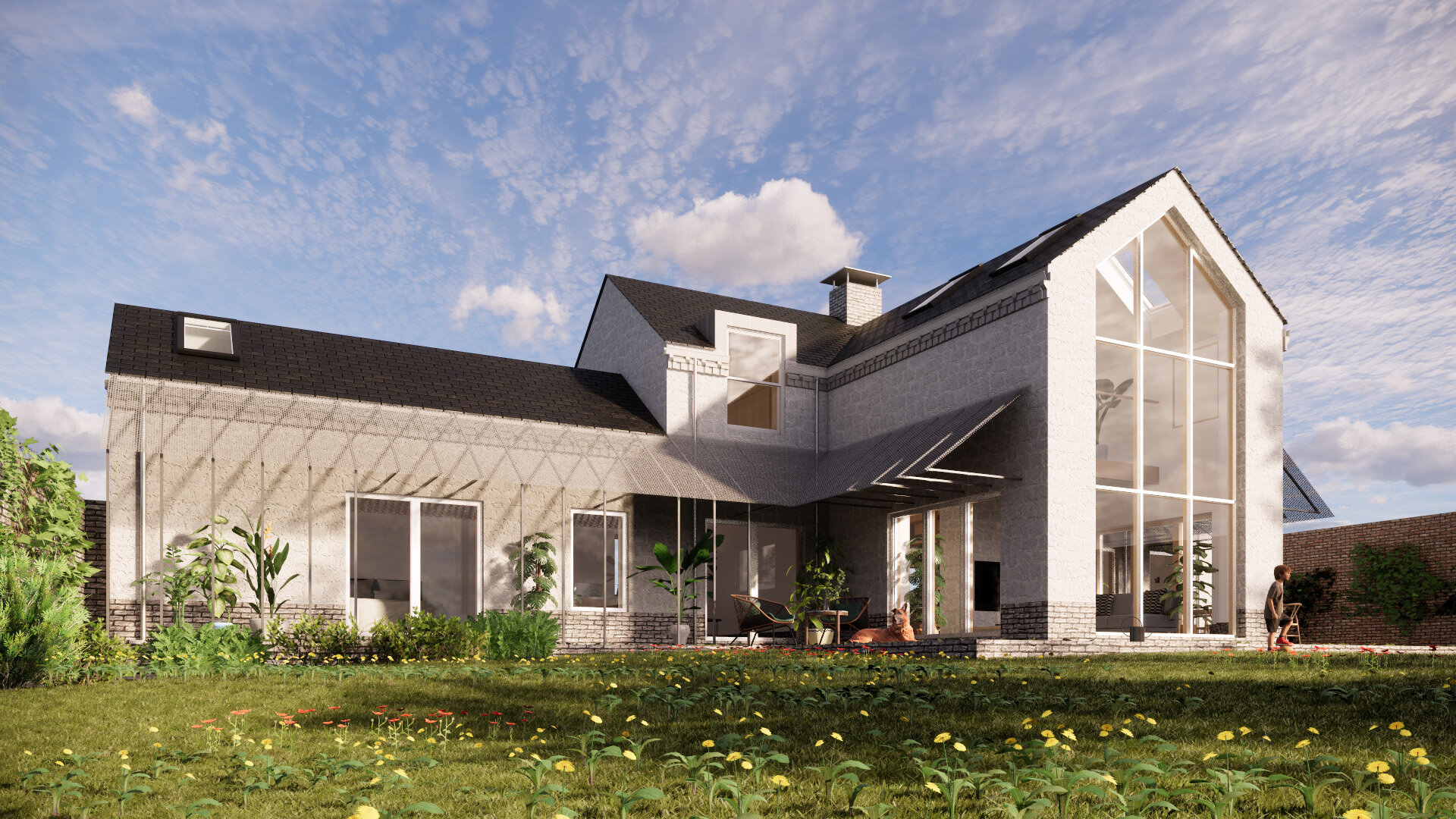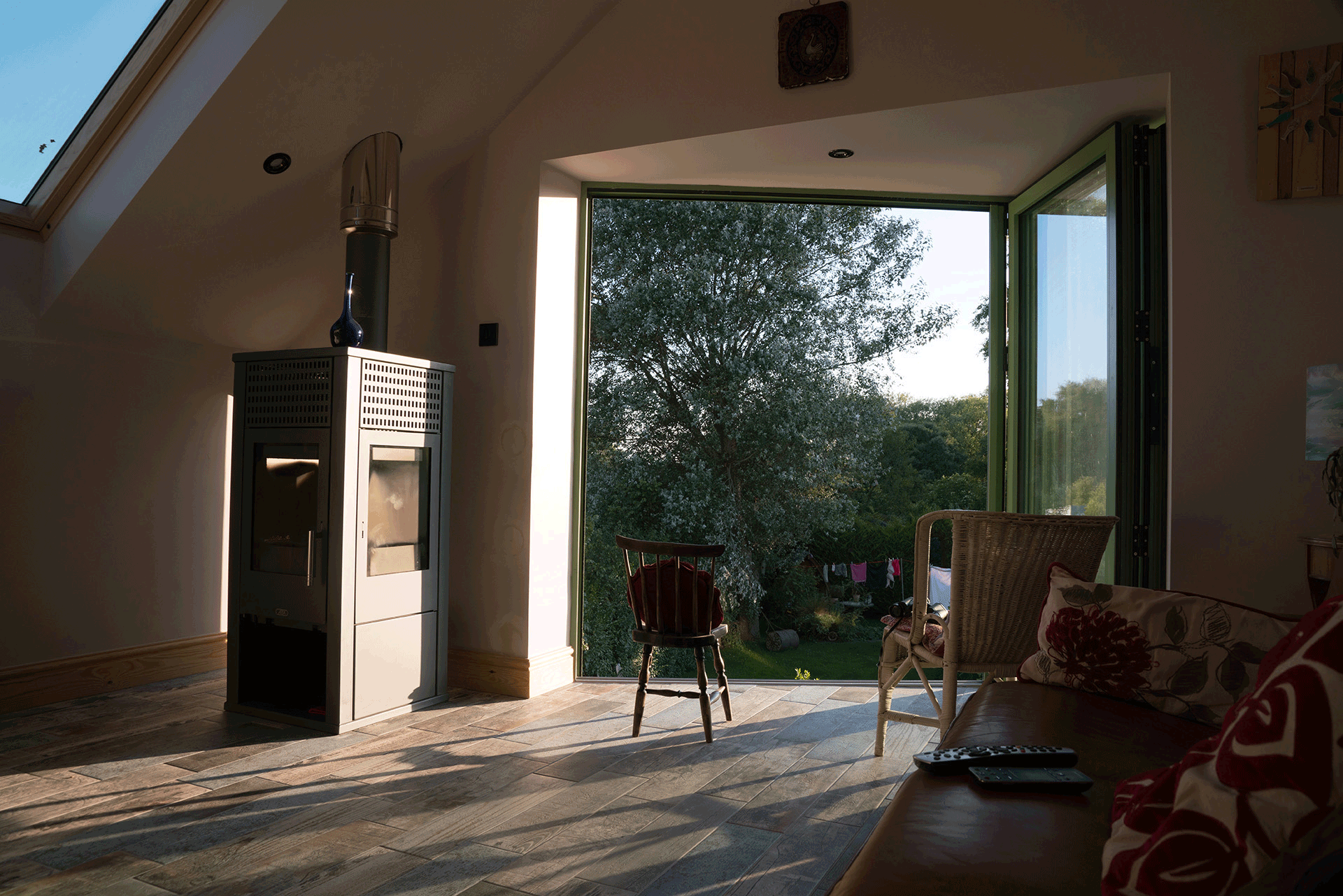The dream of a home with no running costs, no energy from the grid but instead generating energy profit may seem to of reach to most, but at Samuel Kendall Associates this is a dream we have realised many times through careful passive solar design, innovative renewable energy systems and a holistic understanding of what makes sustainable architecture.
1 - Maximise Insulation, Minimise Heating Demand
Mereside House, an eco-friendly extension with no heating bill.
The most critical strategy to achieving a low energy home is to minimise the heat lost through the walls of your home. If you are working with an existing building a great strategy for lowering wall heat loss is to apply a new layer of insulation to the external face of the house. This is known as a warm structure approach.
We employed such a strategy at our recently completed Mereside House project, applying 175mm of rigid insulation to bring their thermal performance up to Passivhaus standards achieving a U value of 0.15 W/m²K.
Applying insulation to the exterior of your home avoids the inherent cold bridging at the join between the walls and floor of the building, which is very difficult to isolate if insulation is applied internally. Our new project for an EnerPHit house in Scarborough wraps an existing 1950’s home with a new skin of high-performance insulation and locally sourced cladding, this will prolong the life of the building for many decades and drop the cost of heating the property substantially.
When creating a bespoke home you have the opportunity to achieve extreme levels of thermal efficiency.
Our new Passivhaus project in Scarborough is being built with insulated concrete formwork, a sandwich system of polystyrene insulation with a cast concrete core that will achieve a calculated U value of 0.08 W/m²K reaching a level of efficiency where central heating becomes unnecessary. The home relies purely on natural solar gain and the heat of the residents to reach comfortable heating levels.
Our East Yorkshire Passivhaus project reaches similarly high levels of thermal efficiency using a SIPS panel system. An offsite manufacture structural system which can be assembled on-site at a fast pace. The project integrates a metallic mesh veranda on its south facade, shading from the high summer sun and preventing overheating in the home.
2 - Harvest Your Site’s Energy
The environment around every home holds free latent energy that makes gas lines and oil tanks seem inconvenient, high maintenance and trivial. The ground, air and sun can provide enough energy for any home if it is channelled and stored in a coherent, efficient way.
The ground of your home is frequently warmed by the sun and as rain soaks into your site its capacity for absorbing heat is greatly increased, becoming a free, massive, low maintenance heat battery. This geothermal heat can then be harvested through a ground source heating system as employed in our Code 5 Sustainable Home in Etton, East Yorkshire. The home’s site provided the great opportunity to install a 14kW Dimplex heat pump which provided ample heating for the 7 bedroom family home.
The air around you is also a great source of free heat which can be harvested through an air source heat pump. This renewable system pulls latent heat from the air in a similar manner to a fridge, but in reverse. Once the heat is captured it is stored within a water cylinder which can then be pumped to underfloor heating or traditional radiators. We installed an 11.2kW Mitsubishi Ecodan ASHP in our recently completed eco-extension project at Mereside house, a sustainable Edwardian terrace house overlooking Hornsea Mere. The home is fully heated by the ASHP and generates a profit in energy, removing their heating bill entirely.
The third component of on-site energy is sunlight. Through solar panels this free energy source can be used for hot water heating or with PV panels converted to electricity, powering the lighting and energy needs of your home. Optimising your home to absorb solar energy in a passive sense is also a great way to lower your energy demands at no active cost. We recently installed a 10-panel array onto our Rosemary House project, providing 10kW at a cost of £4970. Ideally, a solar PV array should be paired with a battery storage system such as a Tesla Powerwall, allowing the day’s energy to be stored and used at night.
3 - Embed Passive Solar Design Principles
Passive solar principles are the environmental effects that allow a home to be heated and cooled automatically with no active energy or heating cost. We outlined these in great detail in our Passive Solar Design Guide but will explain the three most powerful effects to integrate into your home - thermal mass, stack ventilation and solar orientation.
Thermal mass is a material property inherent in concrete, stone, bricks and water which allows those materials to store heat absorbed from the sun or fires (a warm hearth for example). This heat is naturally radiated to the air of your home after the Sun has passed over (during evenings and nights) which thermally compensates for the otherwise cold times of the day, all of our projects integrate thermal mass strategies exemplified clearly by our recent Mereside House eco-extension. Thermally massive elements of the home such as floors, walls, fireplaces and chimneys must be within the home’s insulating line and directly exposed to solar rays to have useful passive effects. Thermally massive elements do not have to be overly thick with good levels of benefit from depths of between 100 and 200 mm - the denser the material, the better the thermal storage and less thickness will be needed. These thermal storage elements should ideally be dark in colour for maximum heat absorption. This free heat storage is ideally paired with orchestrated ventilation currents cultured throughout the home’s layout - tall spaces with extracts at the top (atria and double-height holes) are ideal conditions for the second vital passive process of stack ventilation.
Stack ventilation allows the natural buoyancy and rising qualities of warm air (stratification) to pull fresh warm air vertically through the home, this is a very popular effect we always integrate into the staircases and landings of our projects, notably in Saxton House, Etton House and Heptonstall. This effect occurs best in tall spaces with a thermally massive base and skylights or air extract systems at the top which pulls the naturally rising warm air up and out of the building.
The south side of your home will provide the majority of solar heat gain and natural lighting, making it the ideal side of your home for living space, glazed sun-spaces, balconies and ideally the majority of your garden. Our project at Warley Cottage holds a glazed sun-space at its heart oriented south for optimal heat gain.
The east brings low morning sun and as such is perfect for bedrooms and kitchens, enabling ample morning light as you wake and have breakfast. Our passive solar home at Heptonstall exemplifies these points with a generous east-facing kitchen enjoying the rising sun.
Western aspect provides low evening sun, warming your home in the winter evenings and also provides a portion of prevailing summer winds which if correctly channelled can provide great levels of cooling, cross ventilation through our increasingly hot summers. Living spaces, terraces and sun lounges are perfect areas to place on this side of the home as seen in our new Twin House project near Hull.
Although the north side of your home receives far less direct sun than other sites, these are ideal conditions for utility rooms, bathrooms, plant rooms and WCs, where keeping cool is useful, but perhaps the most useful areas to orient north are workspaces. Working areas are an increasingly common feature in modern homes & the diffuse, even light, low solar glare and minimal overheating risks offered by north aspect are perfect conditions for artist studios, offices and galleries. Our own office receives ample diffuse north and top light, perfect for a healthy, contemporary office.
4 - Store Energy & Rain
Your home is constantly hit by some form of useful resource, be that sunlight, wind or rain all of which can help power an off-grid home.
Solar energy captured by solar panels can be stored in on-site batteries or within a borehole thermal energy storage system, burying the heat energy deep underground. The rainfall on your site is another valuable resource which can be stored in subterranean rainwater harvesting tanks. Keeping this water will lower your mains water bill and potable water wastage in non-drinking applications. Harvested rainwater can flush your toilets, irrigate your garden, fuel your washing machines as well as many other domestic applications, an interesting one would be to irrigate a green wall within your home, which would purify your air and connect more strongly to nature.
5 - Create An Efficient House Envelope
A basic rule of heat loss is the greater your home’s surface area, the more heat you will lose. Using sharp corners in the design will further this heat loss as it creates a more complex envelope. Heat is lost from your home primarily by conducting through your walls and through convection from air extracts, draughts and openings.
Our Scarborough Passivhaus project has a very efficient external envelope and by embedding the home into the site’s hillside we have lowered the home’s exposed surface area. The submerged sides of the home will lose heat at a slower rate due to the high density of earth. Earth is thermally massive which slows its temperature change (thermal lag). Earth sheltering your home will also protect it from harsh winter wind and rain, which can degrade the building’s materials and steal heat through any air gaps in your home’s envelope.


















